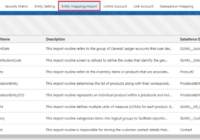Effortlessly Import Sync with GUMU’s new “Create Integration Stats” Checkbox in the Entity Mapping Header
In this blog post, we’ll explore a new GUMU enhancement that introduces a “Create Integration Stats” checkbox in the Entity Mapping Header. This feature provides users with the option to manage the generation of records in the Integration_Statistics__c object during the import routine sync. Since these records are generated as part of the sync process,… Read More »


